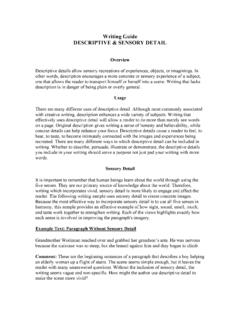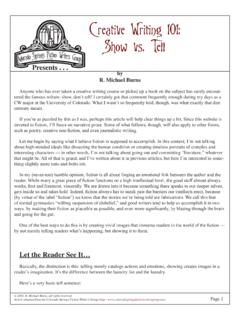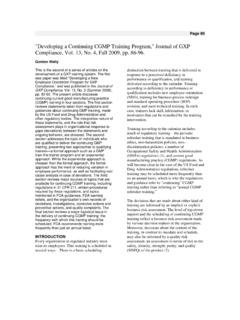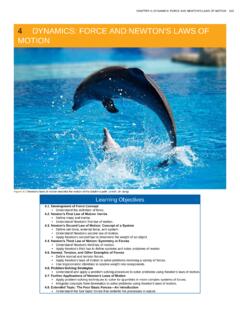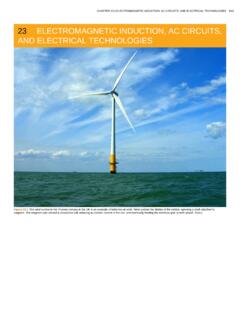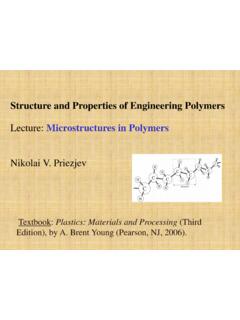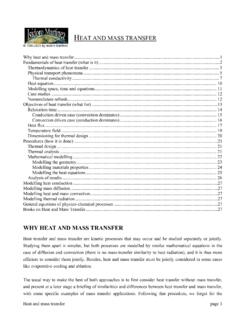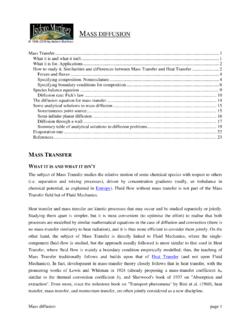Transcription of 14 HEAT AND HEAT TRANSFER METHODS
1 14 heat AND heat TRANSFER METHODSF igure (a) The chilling effect of a clear breezy night is produced by the wind and by radiative heat TRANSFER to cold outer space. (b) There was once great controversyabout the Earth s age, but it is now generally accepted to be about billion years old. Much of the debate is centered on the Earth s molten interior. According to ourunderstanding of heat TRANSFER , if the Earth is really that old, its center should have cooled off long ago. The discovery of radioactivity in rocks revealed the source of energythat keeps the Earth s interior molten, despite heat TRANSFER to the surface, and from there to cold outer heat Define heat as TRANSFER of Temperature Change and heat Capacity Observe heat TRANSFER and change in temperature and mass .
2 Calculate final temperature after heat TRANSFER between two Phase Change and Latent heat Examine heat TRANSFER . Calculate final temperature from heat heat TRANSFER METHODS Discuss the different METHODS of heat Conduction Calculate thermal conductivity. Observe conduction of heat in collisions. Study thermal conductivities of common Convection Discuss the method of heat TRANSFER by Radiation Discuss heat TRANSFER by radiation. Explain the power of different to heat and heat TRANSFER MethodsEnergy can exist in many forms and heat is one of the most intriguing.
3 heat is often hidden, as it only exists when in transit, and is transferred by anumber of distinctly different METHODS . heat TRANSFER touches every aspect of our lives and helps us understand how the universe functions. ItCHAPTER 14 | heat AND heat TRANSFER METHODS 469explains the chill we feel on a clear breezy night, or why Earth s core has yet to cool. This chapter defines and explores heat TRANSFER , its effects, andthe METHODS by which heat is transferred. These topics are fundamental, as well as practical, and will often be referred to in the chapters HeatInWork, Energy, and Energy Resources, we defined work as force times distance and learned that work done on an object changes its kineticenergy.
4 We also saw inTemperature, Kinetic Theory, and the Gas Lawsthat temperature is proportional to the (average) kinetic energy of atomsand molecules. We say that a thermal system has a certain internal energy: its internal energy is higher if the temperature is higher. If two objects atdifferent temperatures are brought in contact with each other, energy is transferred from the hotter to the colder object until equilibrium is reached andthe bodies reach thermal equilibrium ( , they are at the same temperature). No work is done by either object, because no force acts through adistance.
5 The TRANSFER of energy is caused by the temperature difference, and ceases once the temperatures are equal. These observations lead tothe following definition ofheat: heat is the spontaneous TRANSFER of energy due to a temperature noted inTemperature, Kinetic Theory, and the Gas Laws, heat is often confused with temperature. For example, we may say the heat wasunbearable, when we actually mean that the temperature was high. heat is a form of energy, whereas temperature is not. The misconception arisesbecause we are sensitive to the flow of heat , rather than the to the fact that heat is a form of energy, it has the SI unit ofjoule(J).
6 Thecalorie(cal) is a common unit of energy, defined as the energyneeded to change the temperature of g of water C specifically, C, since there is a slight temperaturedependence. Perhaps the most common unit of heat is thekilocalorie(kcal), which is the energy needed to change the temperature of kg ofwater C. Since mass is most often specified in kilograms, kilocalorie is commonly used. Food calories (given the notation Cal, andsometimes called big calorie ) are actually kilocalories (1 kilocalorie = 1000 calories), a fact not easily determined from package figure (a) the soft drink and the ice have different temperatures,T1andT2, and are not in thermal equilibrium.
7 In figure (b), when the soft drink and ice areallowed to interact, energy is transferred until they reach the same temperatureT , achieving equilibrium. heat TRANSFER occurs due to the difference in temperatures. In fact,since the soft drink and ice are both in contact with the surrounding air and bench, the equilibrium temperature will be the same for Equivalent of HeatIt is also possible to change the temperature of a substance by doing work. Work can TRANSFER energy into or out of a system. This realization helpedestablish the fact that heat is a form of energy.
8 James Prescott Joule (1818 1889) performed many experiments to establish themechanicalequivalent of heat the work needed to produce the same effects as heat TRANSFER . In terms of the units used for these two terms, the best modernvalue for this equivalence is( ) kcal = 4186 consider this equation as the conversion between two different units of CHAPTER 14 | heat AND heat TRANSFER METHODSThis content is available for free at depiction of Joule s experiment that established the equivalence of heat and figure above shows one of Joule s most famous experimental setups for demonstrating the mechanical equivalent of heat .
9 It demonstrated thatwork and heat can produce the same effects, and helped establish the principle of conservation of energy. Gravitational potential energy (PE) (workdone by the gravitational force) is converted into kinetic energy (KE), and then randomized by viscosity and turbulence into increased average kineticenergy of atoms and molecules in the system, producing a temperature increase. His contributions to the field of thermodynamics were so significantthat the SI unit of energy was named after added or removed from a system changes its internal energy and thus its temperature.
10 Such a temperature increase is observed while , adding heat does not necessarily increase the temperature. An example is melting of ice; that is, when a substance changes from onephase to another. Work done on the system or by the system can also change the internal energy of the system. Joule demonstrated that thetemperature of a system can be increased by stirring. If an ice cube is rubbed against a rough surface, work is done by the frictional force. A systemhas a well-defined internal energy, but we cannot say that it has a certain heat content or work content.

